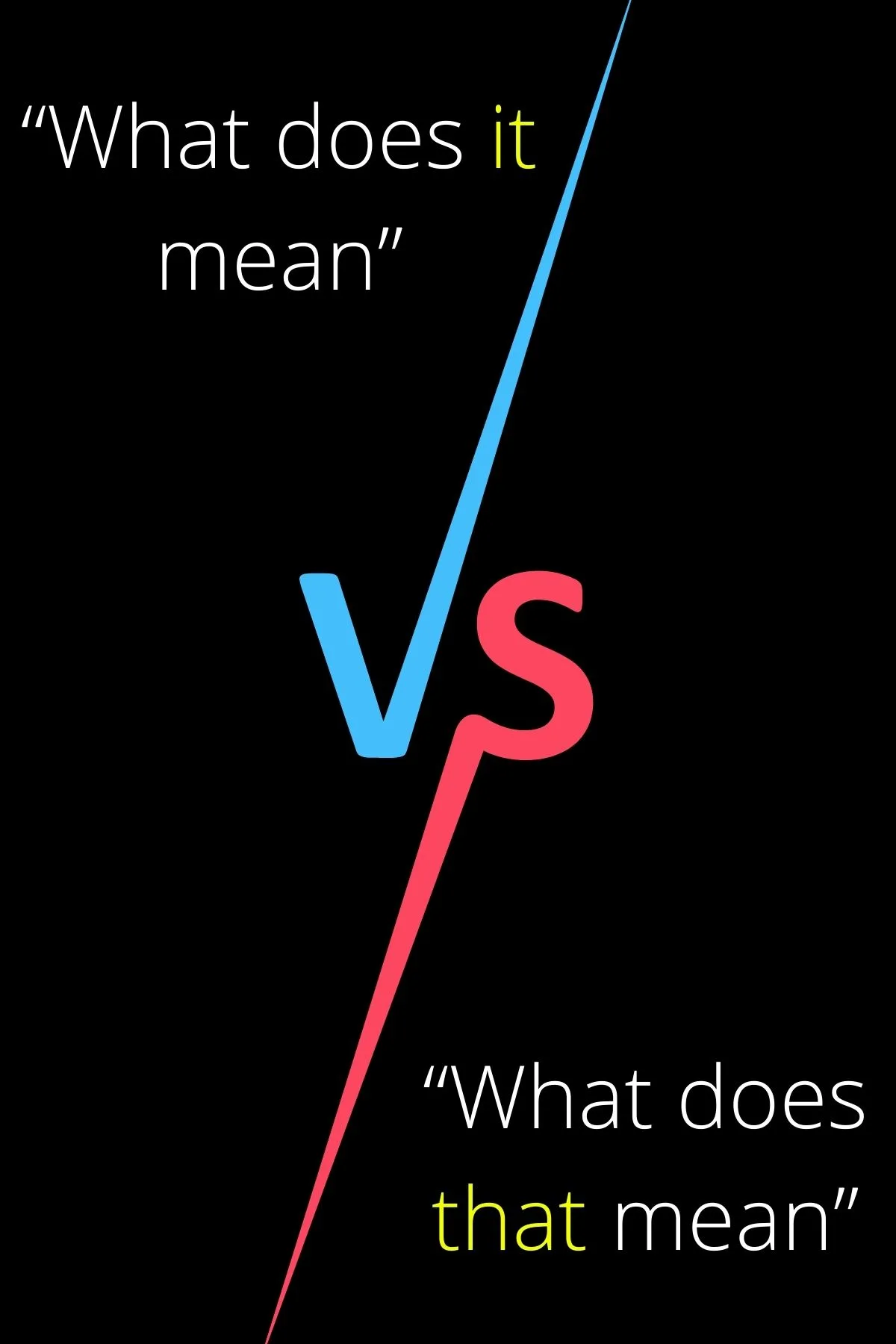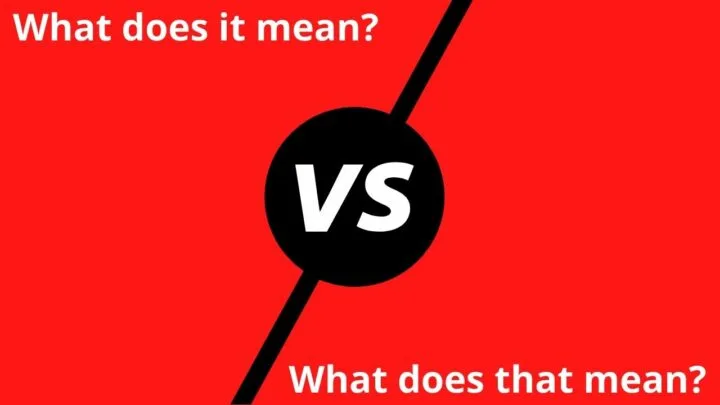Some of the most commonly used pronouns are “it” and “that,” and both can be grammatically used in the question “what does x mean?”
However, people seem to get bothered as to when we should say “what does it mean?” instead of “what does that mean?” and vice versa.
So today, we’ll look into the context and meaning behind each of these two exploratory questions to fill the mentioned interesting gap.
Let’s begin with their main difference.
What is the difference between “what does it mean?” and “what does that mean?”
Usually followed by an infinitive phrase like “to be x,” “what does it mean?” is generally used as an opening remark for dialogs, especially when referring to word meanings and concepts. “What does that mean?” is mainly used as a response to a previous statement and can often stand alone.
The difference between and among expressions may be too subtle such as in “I have got” vs. “I have gotten” which is just a matter of the verb tense used.
Sometimes, the difference can also be about the part of speech such as in “sale” vs. “sell” that it bothers many natives and non-natives alike.
Even spelling misconceptions like in “amature” vs. “amateur” and “wholistic” vs. “holistic” may also test our patience every once in a while.
Another concern among many cybercitizens these days is the fine line that distinguishes the question “what does it mean?” from “what does that mean?”
Having the thirst to understand matters like this is good because it increases our linguistic preciseness, which is crucial in decreasing ambiguities in language use.
Even though “what does it mean?” and “what does that mean?” seem to suggest utterly the same grammatical meaning, they actually have a few differences.
These differences are a bit too elusive ad fine-drawn that they can only be understood when put in proper contexts.
To put things as simply as possible, “what does it mean?” is more of a general rhetorical question, while “what does that mean?” is a specific question that is best understood through a dialog.
Here’s a quick exchange where both questions are asked:
Example:
Teacher: Class, what does it mean to be stereotypical?
Student 1: I think it means believing that a particular group of people behaves in a certain way or has specific traits.
Student 2: Wow. Really? What does that mean?
Student 1: Well, it’s generalizing people. For example, you’re stereotyping when you think all Asians are smart or all Americans are tall.
In a nutshell, the question “what does it mean?” aims to explore or clarify what is said by the speaker or writer, particularly at the surface level.
Meanwhile, the question “what does that mean?” aims to investigate further what is not said by the speaker or writer, especially on a deeper level.
The meaning of the expression “What does it mean?”
So, what does “what does it mean?” mean? Well, when we ask about word meanings and concepts, we usually make use of the question “What does x mean?”
That said, “x” in the statement above can conveniently stand for any word or concept that we would like to know about, understand, or even just ask rhetorically.
Examples:
In situations where we would have to ask questions like the two examples above, we can simply think of “what does it mean?” wherein “it” stands for either “avarice” or “vicarious trauma.”
This kind of situation typically occurs in classroom discussions or in language-learning articles like the one you are reading now.
Having the goal of evoking responses from students while stimulating them to think more, teachers normally open their discussions with what-does-it-mean questions.
Likewise, language blog writers also make use of this sentence format, particularly in the heading of a section that aims to present word meanings and concepts.
In another yet related angle, “what does it mean…” is also usually followed by an infinitive phrase like “to be x.”
This language structure is also generally used as an opening remark, often rhetorically, for deep conversations and presentations.
Not only limited to that, “what does it mean to be x?” is also typically used as article or book titles as well as heading and chapter titles.
Examples:
If we think about it, “what does it mean?” is simply a general rhetorical question used by speakers and writers who want to emphasize the meaning of something.
“What does it mean?” is hence a more superficial question compared to “what does that mean?”
In other words, while a person asking with “what does it mean?” is interested in the surface meaning of something, a person asking with “what does that mean?” is keen on knowing the implication of something.
“What does it mean?” is different from “what does that mean?” because the latter is also rather used as a more specific, context-based response to a previous statement.
In the next example, you will see that “what does it mean?” instead of “what does that mean?” makes little to no sense and that it also evokes a different response.
Example:
A: Andrew said he’s broke.
B: What does it mean?
C: Well, it means he’s got no money.
However, in the example below, which is in a similar context, you will see how “what does that mean?” changes the possible response of the first speaker.
Example:
A: Andrew said he’s broke.
B: What does that mean?
C: Well, it means he needs to live with his parents from now on.

The Meaning of “What does that mean?”
Now, what about “what does that mean?” How is this question different from the previously-explained question “what does it mean?”
When we ask about the implication or deeper meaning of something that has been said or done by another person, we mainly use the question “what does that mean?”
Therefore, “that” in “what does that mean?” is context-dependent and cannot be easily explained without using it in a conversation or a text.
Example:
A: I can’t believe what just happened. (Sighing and looking glum)
B: Why? What does that mean?
In the example dialog above, the second speaker is asking what the first speaker implies and wants to hear more of the story.
So, “what does that mean?” is more like a “why?” or “what happened?” question as opposed to “what does your statement mean?”
In other words, asking the question “what does that mean?” suggests asking for the result or consequence of the referred situation or event, such as in the example below:
Example:
A: Our company just got acquired.
B: What does that mean for you?
If we compare “what does that mean?” with “what does it mean?” we can understand that the pronoun “that” also helps in conveying more emphasis than “it.”
So, “what does that mean?” may also just be the same as “what does that imply?” or “what happens to you now?”
As you can see, “what does that mean?” is particularly used when referring to something very specific to the context of the conversation or situation.
This also implies that the speaker or writer is expected to explain more or give more details when asked the question “what does that mean?”
Example:
A: Sally just got engaged with Barry.
B: What does that mean?
A: It means I have to let go of her now and move on with my life.
Using “what does it mean?” in a similar context would encourage a different response, which often makes little to no sense.
It may also make the speaker feel like “literally” explaining what has just been said.
Example:
A: Sally just got engaged with Barry.
B: What does it mean?
A: It means Barry asked Sally to marry him.
The meaning of “what it mean”
“What it mean” is neither a grammatically correct question nor a statement. More precisely, “what does it mean?” and “what it means” are the correct forms to use.
“What does it mean?” is a general question regarding word meanings and concepts, whereas “what it means” is a phrase in the simple present tense used to introduce an explanation.
Example:
To put things simply, “what it means” is what you would use in a declarative statement instead of “what does it mean?”
So, “what it means” is what you would use to embed or implant the question “what does it mean?” in a declarative or informative statement form.
Example:
Frequently Asked Questions on “What does it mean?” vs “What does that mean?”
Is the question “what is that mean” correct?
“What is that mean” is a grammatically incorrect question that is used instead of the “What does that mean?” When constructing simple present questions in English with wh-question words like “what,” we have to use “does” and not “is.”
Is “does that mean” the same with “is that mean”?
“Does that mean” is not the same as “is that mean” because the latter is an incorrect grammatical construction for simple present questions. For example, we have to say “does that mean you have to live by yourself now?” and not “is that mean you have to live by yourself now?”
How can we use “what does that mean” in a sentence?
To use “what does that mean” in a sentence, it can either stand by itself or be followed by a prepositional phrase like in “what does that mean for you?” Most of the time, “what does that mean?” is used as stand-alone follow-up question after a previous statement.

Hey fellow Linguaholics! It’s me, Marcel. I am the proud owner of linguaholic.com. Languages have always been my passion and I have studied Linguistics, Computational Linguistics and Sinology at the University of Zurich. It is my utmost pleasure to share with all of you guys what I know about languages and linguistics in general.

